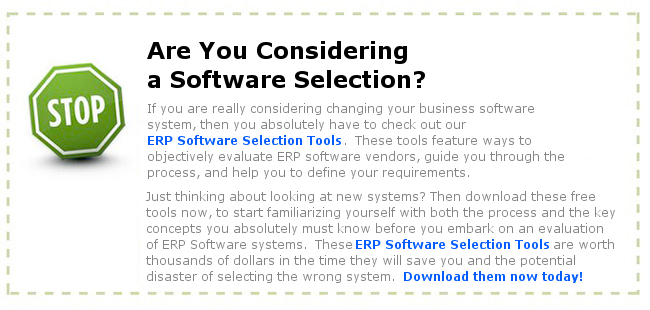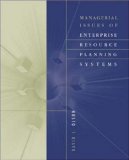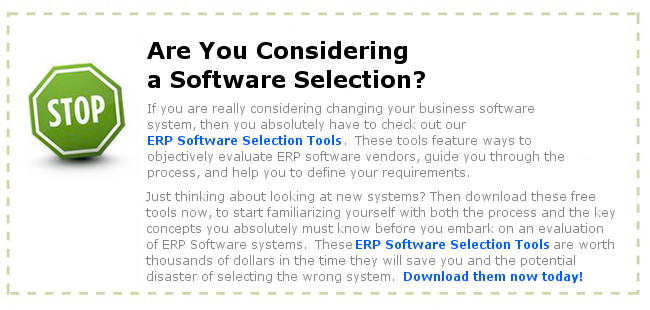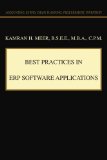Product Description
The primary purpose of this text is to lay out the scope of ERP Systems implementation, explain the competitive advantages of using ERP Systems, and support general concepts with short case studies. This text covers the fundamental issues important in ERP implementation and management, starting from an information systems, information technology project management perspective. Each chapter will include a review of real cases of ERP implementations related to that p… More >>
Tag: planning a wedding
Best Practices in ERP Software Applications: Accounting, Supply Chain Planning, Procurement, Inventory
Product Description
The purpose of Best Practices in ERP Software Applications is to disseminate knowledge about the state-of-the-art in ERP (Enterprise Resource Planning) systems and the business best practices embedded in the systems.It is written for business professionals, project managers, consultants, team leaders, programmers, technicians, vendors, service providers, executives, teachers and students who are working, managing or studying in the field of software application deve… More >>
Best Practices in ERP Software Applications: Accounting, Supply Chain Planning, Procurement, Inventory

Enterprise Resource Planning: Dr. Norma Davis
Dr. Norma Davis, management consultant talks with Oliver Hamilton about enterprise resource planning (ERP).
Project Management Planning vs. Task Management
Project Management for ERP cannot be understated. It is the essential tool for ensuring a successful launch of a new Enterprise Software system. Understanding the Scope, the Time Frame, the Budget, the People/Resources available, and the goals are all important. Many people use a tool such as MS Project to plan the various stages and tasks to complete.
There is a fundamental difference between planning a project and tracking it. On a project team there are various assignments and tasks that need to be accomplished. MS Project is often cumbersome to track detailed tasks. Especially those that come up in steering committee meetings and even on phone calls.
Being able to track them requires a useful tool to manage all the tasks. This is different than Microsoft Project. MS Project is a great planning tool. But to manage the various sub-projects and tasks, we have started using Nozbe. Check it out. We have put up a link on the sidebar of our site to assist you. Another good resource for various project software is http://www.gtdsoftware.net.
Enterprise Resource Planning Software Will Grow to $29 Billion in 2006
BOSTON, Oct. 10 /PRNewswire/ — Today, AMR Research released a report that stated the enterprise resource planning (ERP) applications market grew to $25.4B in 2005, and will reach $29B in 2006. Over the next five years, the market will grow at an average of 10%. The ERP market continues to benefit from a widespread acceptance of the idea that businesses must have integrated information systems to be competitive. Management and IT organizations are realizing that the most effective way to satisfy this need is to purchase an ERP package that features broad functionality and pre-built integration.”The integrated versus best-of-breed debate still goes on in some organizations, but the suite advocates are clearly winning,” said Jim Shepherd, senior vice president of research at AMR Research. “In addition, we now see many of the remaining ERP vendors compete effectively with companies of all sizes.”Continuing the trend of fewer vendors owning a larger share of the market, SAP and Oracle now represent 65% of new license sales.
| Growth |
| Revenue Growth Rate |
| 2005 Revenue Revenue Share Rate, Forecast, |
| Revenue Share, Share, Forecast, 2004- 2005- |
| Rank Company Name 2004 2005 2006 2005 2006 |
| 1 SAP 40% 42% 43% 12% 17% |
| 2 Oracle 10% 20% 23% 110% 29% |
| 3 Sage Group 5% 6% 5% 16% 10% |
| 4 Microsoft 3% 4% 4% 15% 18% |
| 5 SSA Global 3% 3% 3% 7% 3% |
AMR Research’s depth and breadth of quantitative research is augmented with industry expertise by the firm’s research analysts. The Market Analytix Report Series provides technology vendors with targeted marketing and competitive information on key application markets of ERP, SCM, CRM, procurement, PLM, and HCM. For more information or a copy of the formal ERP report, please contact AMR Research at (617) 542-6600. Additional information can also be found on the company’s website .About AMR Research:Research and Advice that Matters: AMR Research is the No. 1 advisory firm focused on supply chain, enterprise applications, and infrastructure. Founded in 1986, AMR Research provides advisory services and peer networking opportunities to supply chain and technology professionals in the manufacturing and retail sectors. To learn more about our research and services, visit http://www.amrresearch.com .
ERP (Enterprise Resource Planning) Overview
ERP (Enterprise Resource Planning) Overview covers What is ERP, Brief history of ERP, Why is it necessary, Market Leaders and the future of ERP. What is ERP? Enterprise Resource Planning or ERP is an industry term for integrated, multi-module application software packages that are designed to serve and support multiple business functions. An ERP system can include software for manufacturing, order entry, accounts receivable and payable, general ledger, purchasing, warehousing, transportation and human resources. Evolving out of the manufacturing industry, ERP implies the use of packaged software rather than proprietary software written by or for one customer. ERP modules may be able to interface with an organizations own software with varying degrees of effort, and, depending on the software, ERP modules may be alterable via the vendors proprietary tools as well as proprietary or standard programming languages.
Brief History of ERP The focus of manufacturing systems in the 1960s was on Inventory control. Most of the software packages then (usually customized) were designed to handle inventory based on traditional inventory concepts. In the 1970s the focus shifted to MRP (Material Requirements Planning) systems that translated the Master Schedule built for the end items into time-phased net requirements for the sub-assemblies, components and raw materials planning and procurement.
In the 1980s the concept of MRP II (Manufacturing Resources Planning) evolved which was an extension of MRP to shop floor and Distribution management activities. In the early 1990s, MRP II was further extended to cover areas like Engineering, Finance, Human Resources, Projects Management etc i.e. the complete gamut of activities within any business enterprise. Hence, the term ERP (Enterprise Resource Planning) was coined.
Why is it Necessary? By becoming the integrated information solution across the entire organization, ERP systems allow companies to better understand their business. With ERP software, companies can standardize business processes and more easily enact best practices. By creating more efficient processes, companies can concentrate their efforts on serving their customers and maximizing profit.
Market Leaders The top five ERP vendors, SAP, Oracle Corporation, Peoplesoft, Inc. (now Oracle Corp.), JD Edwards & Company, and Baan International, account for 64 percent of total ERP market revenue. These vendors continue to play a major role in shaping the landscape of new target markets, with expanded product functionality, and higher penetration rates. SAP dominates the $6.7 billion ERP applications market in Europe with 39% market share. Oracle and PeopleSoft come second and third respectively, followed by SAGE Group and Microsoft Business Solutions.
The Future of ERP Industry analysts expect that every major manufacturing company will buy the software, which ranges in cost — with maintenance and training — from hundreds of thousands of dollars for a small company to millions for a large company. AMR Research of Boston says consolidation among the major players will continue and intensify. ERP vendors are expected to put more effort into e-commerce, CRM and SCM initiatives, with leaders redirecting between 50% and 75% of their R&D budget to these projects.
According to Gartner research group, the rapid evolution of ERP has already lead to a new corporate must-have, ERP II, which is supposed to help businesses gain more competitive edge in the future. The major difference is that ERP II involves collaborative commerce, which enables business partners from multiple companies to exchange information posted on eCommerce exchanges.
In the next tutorial we will talk about popular ERP Products and the Modules and Application related to them.
For more visualization of this article along with the screen shots and more visit with step by step instructions, http://www.exforsys.com/content/category/17/260/342/
Exforsys is a community of developers specializing in C, C++, C#, Java, J2EE, .NET, PeopleSoft, SAP, Siebel, Oracle Apps., Data warehousing, Oracle/SQL Server/DB2 and Testing. Please visit http://www.exforsys.com for more tutorials and for Interview questions http://www.geekinterview.com is an open database.
The Return of Sales and Operations Planning
In many manufacturing organizations, a lack of nimbleness and automation in existing sales and operations planning (S&OP) processes has stunted management’s ability to drive change. Companies looking to maximize the value of their supply chain and operational investments must automate cross-organizational performance planning processes to enable operational performance management.
Intelligent Enterprise Magazine: The Return of Sales and Operations Planning


